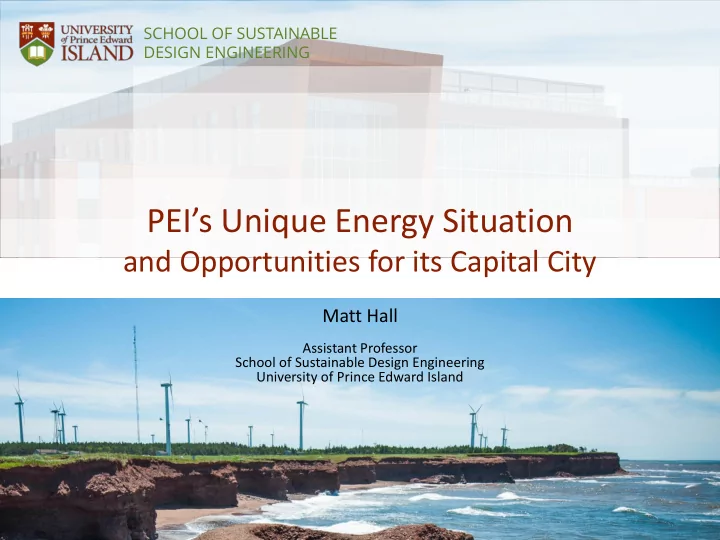

SCHOOL OF SUSTAINABLE DESIGN ENGINEERING PEI’s Unique Energy Situation and Opportunities for its Capital City Matt Hall Assistant Professor School of Sustainable Design Engineering University of Prince Edward Island
PEI’s Energy System is Unique • 98% of electricity generated on PEI comes from wind turbines PEI’s Primary Electricity Source: Wind • 40% of electricity consumed on PEI comes from Island wind* • PEI’s emissions are mostly from transportation, buildings, and agriculture Energy Fact Book 2016-2017, Natural Resources Canada Image: 2016/2017 Provincial Energy Strategy: www.peiec.ca
We Have Great Sustainable Energy Examples • The Island uses its strong wind resource – 204 MW of wind turbines – highest wind energy ratio of any province • Summerside is a leader in clean energy – own electrical utility – 12 MW wind farm, new solar array – smart grid and household thermal storage – electric vehicle charging stations • New opportunities are emerging – batteries and solar panels becoming competitive – ongoing electrification of heating (heat pumps) – impending electrification of transportation (Evs)
Problem: Supply and Demand Must Balance Connection to NB Power PEI Energy Commission Final Report: Charting Our Electricity Future – September 2012
Reliance on New Brunswick • Reliance on NB Power for electricity imports and supply-demand balancing is a cost and a source of price uncertainty • How can we reduce greenhouse gas emissions, costs, and uncertainty? PEI Electricity Mix in 2014 Energy Fact Book 2016-2017 Natural Resources Canada PEI Provincial Energy Strategy 2016-2017
What if we cut the cable? • What would it take for PEI’s electricity use to be 100% from on-Island wind and solar? • Scenarios using a year’s worth of data for demand, wind power, and solar power
Simulating Different Wind-Solar Scenarios at every moment, • Analyze electricity generation, demand, and SUPPLY = DEMAND storage on a 30 minute basis for one year WIND • Try different amounts of wind, solar, and LOAD battery storage to meet demand at all times SOLAR EXCESS – energy storage (in case of no wind/sun) STORAGE – curtailment of excess wind/solar • Take advantage of seasonal trends • Estimate costs – wind: $2/W plus O&M, 20 year lifetime – solar: $2/W plus O&M, 30 year lifetime – battery storage: $500/kWh capacity, variable lifetime
WIND Scenario 1: 100% Wind Power LOAD STORAGE • 450 MW of wind turbines, 132 GWh of energy storage • More wind in winter means a year’s worth of storage is required • Cost of energy: $2.9/kWh
WIND Scenario 2: Mix of Wind and Solar LOAD SOLAR STORAGE • 313 MW of wind, 350 MW of solar, 41 GWh of storage • Storage requirement is reduced from 132 GWh to 41 GWh • Cost of energy: $1.0/kWh
WIND Scenario 3: Curtailment of Excess LOAD SOLAR EXCESS STORAGE • 351 MW of wind, 1220 MW of solar, 12 GWh of storage • Oversizing generation reduces storage from 41 GWh to 12 GWh • Cost of energy: $0.46/kWh
WIND Scenario 4: Low Cost Storage LOAD SOLAR EXCESS CHEAP • 537 MW of wind, 246 MW of solar, 17 GWh of storage STORAGE • Cheap storage makes costs plausible • Cost of energy: $0.15/kWh
What this tells us • Moving towards electricity independence and 100% renewable sources… – is technically feasible – is aided by the addition of solar power – is aided by allowing curtailment of excess renewable energy – is prohibitively expensive at current battery costs – is affordable if energy storage costs fall dramatically
What is the Role of Cities? • Charlottetown Emissions Energy and emissions are about how people live • 25% of PEI’s population is in Charlottetown 1. transportation is over ¼ of emissions 2. heating is maybe ½ of emissions – both are increasingly being electrified • Re-Energizing Canada report from 72 scholars commissioned by Natural Resources Canada – first two fields of action: 1. Re-imagining transportation 2. Cities as sustainability laboratories www.sustainablecanadadialogues.ca/en/scd/energy
Re-Energizing Canada, Sustainable Canada Dialogues, 2017
In a city, energy sustainability comes with comfort and convenience • A greener and smarter grid with renewable energy and demand response programs – know where your energy comes from, be paid to change use • Community-scale aggregation of energy producers and consumers – be able to invest in local renewable generation, reduce costs • Energy efficiency initiatives (especially for buildings) – more comfort at home and work in the winter • Widespread public transport, good bus shelters • Bike paths/lanes for commuters, bike sharing programs – convenient and safe active transportation options city-wide • Electric vehicle and car sharing infrastructure – Be able to own (or hire on short notice) an electric car
Conclusion Low-cost storage • Energy innovations have many benefits: Reduce – Connected community energy systems (demand response) emissions, – Walking, biking, public transit, car sharing save money, – Electric vehicles (battery storage) improve quality of life – Heat pumps and better building insulation (thermal storage) • In a city, energy sustainability is about reducing emissions, reducing costs, and improving quality of life • PEI is unique; if our energy sustainability actions are smart, we can play a big role in PEI’s supply -demand challenge and enable a greener and more self-sufficient island. contact: mthall@upei.ca
Recommend
More recommend